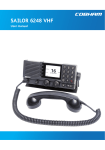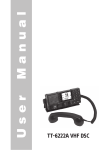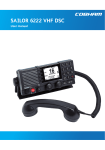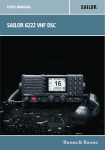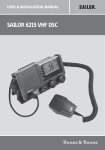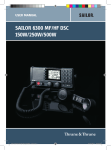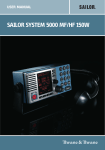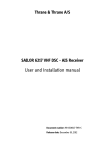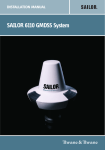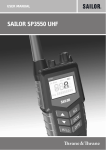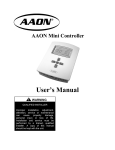Download SAILOR 6248 VHF - NAVAL marine GmbH
Transcript
USER MANUAL SAILOR 6248 VHF SAILOR 6248 VHF User manual Document number: 98-131186-A Release date: May 24, 2011 Disclaimer Any responsibility or liability for loss or damage in connection with the use of this product and the accompanying documentation is disclaimed by Thrane & Thrane. The information in this manual is provided for information purposes only, is subject to change without notice and may contain errors or inaccuracies. Manuals issued by Thrane & Thrane are periodically revised and updated. Anyone relying on this information should acquire the most current version e.g. from http://www.thrane.com or from the distributor. Thrane & Thrane is not responsible for the content or accuracy of any translations or reproductions, in whole or in part, of this manual from any other source. Copyright © 2011 Thrane & Thrane A/S. All rights reserved. Trademark Acknowledgements • Thrane & Thrane is a registered trademark of Thrane & Thrane A/S in the European Union and the United States. • SAILOR is a registered trademarks of Thrane & Thrane A/S. • Other product and company names mentioned in this manual may be trademarks or trade names of their respective owners. GPL notification The software included in this product contains copyrighted software that is licensed under the GPL/LGPL. The verbatim licenses can be found online at: http://www.gnu.org/licenses/old-licenses/gpl-2.0.html http://www.gnu.org/licenses/old-licenses/lgpl-2.1.html You may obtain the complete corresponding source code from us for a period of three years after our last shipment of this product, which will be no earlier than December 31, 2015, by sending a money order or check for DKK 50 to: SW Technology/GPL Compliance, Thrane & Thrane A/S, Lundtoftegaardsvej 93D 2800 Lyngby DENMARK Please write "source for product SAILOR 6248 VHF" in the memo line of your payment. You may also find a copy of the source at http://www.thrane.com/foss. This offer is valid to anyone in receipt of this information. Warranties Any attempt to install or execute software not supplied by Thrane & Thrane on this device will result in the warranty being void. Any attempt to modify the software on this device in a way not specified by Thrane & Thrane will result in the warranty being void. Safety warning The following general safety precautions must be observed during all phases of operation, service and repair of this equipment. Failure to comply with these precautions or with specific warnings elsewhere in this manual violates safety standards of design, manufacture and intended use of the equipment. Thrane & Thrane assumes no liability for the customer's failure to comply with these requirements. Ground the equipment To minimise shock hazard, the SAILOR 6248 VHF unit must be connected to an electrical ground and the cable instructions must be followed. RF exposure hazards and instructions Your Thrane & Thrane radio set generates electromagnetic RF (radio frequency) energy when transmitting. To ensure that you and those around you are not exposed to excessive amounts of energy and thus to avoid health hazards from excessive exposure to RF energy, all persons must be at least 3ft (0.9 m) away from the antenna when the radio is transmitting. Warranty limitation IMPORTANT - The radio is a sealed waterproof unit (classified IPX8). To create and maintain its waterproof integrity it was assembled in a controlled environment using special equipment. The radio is not a user maintainable unit, and under no circumstances should the unit be opened except by authorized personnel. Unauthorized opening of the unit will invalidate the warranty. Installation and service Installation and general service must be done by skilled service personnel. Compass safe distance Minimum safety distance: 0.85 m from the SAILOR 6248 VHF. iv 1 Emergency calls Make sure your VHF Radio is on CH16 Press Press or Use the HANDSET or SPEAKER MICROPHONE for voice calling MAYDAY-MAYDAY-MAYDAY OWN ID This is NAME-NAME-NAME CALLSIGN or other IDENTIFICATION SHIP‘s NAME: CALLSIGN: MAYDAY NAME of the VESSEL in distress CALLSIGN or other IDENTIFICATION POSITION given as latitude and longitude or If latitude and longitude are not known or if time is insufficient, in relation to a known geographical location NATURE of distress Kind of ASSISTANCE required Any other useful INFORMATION 99-133789 v Preface 2 Radio for occupational use The SAILOR 6248 VHF fulfils the requirements of the EC directive 1999/5/EC, Radio and Telecommunications Terminal Equipment and is intended for use in maritime environment. SAILOR 6248 VHF is designed for occupational use only and must be operated by licensed personnel only. SAILOR 6248 VHF is not intended for use in an uncontrolled environment by general public. SAILOR 6248 VHF is designed for installation by a skilled service person. vi Training information 3 The SAILOR 6248 VHF is designed for occupational use only and is also classified as such. It must be operated by licensed personnel only. It must only be used in the course of employment by individuals aware of both the hazards as well as the way to minimize those hazards The radio is thus NOT intended for use in an uncontrolled environment by general public. The SAILOR 6248 VHF has been tested and complies with the FCC RF exposure limits for Occupational Use Only. The radio also complies with the following guidelines and standards regarding RF energy and electromagnetic energy levels including the recommended levels for human exposure: • FCC OET Bulletin 65 Supplement C, evaluating compliance with FCC guidelines for human exposure to radio frequency electromagnetic fields. • American National Standards Institute (C95.1) IEEE standard for safety levels with respect to human exposure to radio frequency electromagnetic fields, 3 kHz to 300 GHz • American National Standards Institute (C95.3) IEEE recommended practice for the measurement of potentially hazardous electromagnetic fields - RF and microwaves. Below the RF exposure hazards and instructions in safe operation of the radio within the FCC RF exposure limits established for it are described. Warning Your Thrane & Thrane radio set generates electromagnetic RF (radio frequency) energy when it is transmitting. To ensure that you and those around you are not exposed to excessive amounts of that energy (beyond FCC allowable limits for occupational use) and thus to avoid health hazards from excessive exposure to RF energy, FCC OET bulletin 65 establishes an Maximum Permissible Exposure (MPE) radius of 3 ft. (0.9m) for the maximum power of your radio (25W selected) with an half wave omni-directional vii antenna having a maximum gain of 3 dB (5.2dBi). This means all persons must be at least 3 ft. (0.9m) away from the antenna when the radio is transmitting. Installation 1. An omni-directional antenna with a maximum power gain of 5.2 dBi must be mounted at least 9.6 ft. (2.9m) above the highest deck where people may be staying during radio transmissions. The distance is to be measured vertically from the lowest point of the antenna. This provides the minimum separation distance which is in compliance with RF exposure requirements and is based on the MPE radius of 3 ft. (0,9m) plus the 6.6 ft. (2m) height of an adult. 2. On vessels that cannot fulfil requirements in item 1, the antenna must be mounted so that its lowest point is at least 3 ft. (0.9m) vertically above the heads of people on deck and all persons must be outside the 3 ft. (0.9m) MPE radius during radio transmission. • Always mount the antenna at least 3ft (0.9m) from possible human access. • Never touch the antenna when transmitting • Use only authorized T&T accessories. 3. If the antenna has to be placed in public areas or near people with no awareness of the radio transmission, the antenna must be placed at a distance not less than 6 ft. (1.8m) from possible human access. Failure to observe any of these warnings may cause you or other people to exceed FCC RF exposure limits or create other dangerous conditions. viii Manual overview This manual has the following chapters and appendices: Important • Introduction contains a description of the VHF radio. • Operation explains how to make and receive voice calls over VHF, including how to use and set-up scanning, watch and replay. • Service & maintenance contains support information including lists of accessories and a troubleshooting guide. • Appendix with Specifications & Approval and Maritime channels. All installation information and instructions are not covered in this manual. Please download the SAILOR 6248 VHF Installation manual (98-133233) at http://extranet.thrane.com/. In the installation manual you can read how to mount the VHF radio and how to connect accessories and external equipment, including detailed system configuration examples with cable specifications. Related documents Title and description Document number SAILOR 6248 VHF, Installation guide 98-132282 SAILOR 6248 VHF Installation manual (download only) 98-133233 Emergency call sheet 98-133795 ix x Table of Contents Chapter 1 Introduction VHF radio ........................................................................... 1 Accessories available .........................................................4 Chapter 2 Operation Overview ............................................................................7 General use and navigation ...............................................8 VHF radio communication ................................................. 11 Watch ................................................................................15 Scan ..................................................................................15 Phone book .......................................................................16 Replay function ................................................................ 18 Setup ................................................................................19 Chapter 3 Service & maintenance Contact for support ...........................................................25 Maintenance ....................................................................25 Troubleshooting guide .....................................................26 Warranty and returning units for repair ...........................29 App. A Specifications & Approval Transceiver unit SAILOR 6248 VHF .....................................31 SAILOR 6090 Power Converter 24—12 V ............................. 34 Declaration of conformity .................................................35 xi Table of Contents App. B Maritime channels International channels (INT) .............................................37 US channels .....................................................................38 CA channels .....................................................................39 BI channels ..................................................................... 40 Glossary ......................................................................................... 41 Index .........................................................................................43 xii 1111 Chapter 1 1 Introduction Introduction VHF radio SAILOR 6248 VHF is approved to R&TTE, FCC and Industry Canada and is waterproof to the IPx8 and IPx6 standard. As part of the required safety equipment, use the SAILOR 6248 VHF in an emergency situation. However the best way to guarantee functionality in an emergency situation, is to use the radio in daily communication on board. The VHF radio is a simplex/semi duplex VHF radio. It is designed with an easyto-use menu-driven setup. You use the soft-keys and the keypad to enter the desired functions, you browse and select a setting using the right selection knob. The large display can be customized for optimum readability and visibility both day and night with several color themes. The VHF radio can replay the last 240 s of received voice messages. This is a useful feature to minimize misunderstandings and to record messages when the radio is unattended. With SAILOR connection boxes the VHF radio connects easily to external equipment like additional handsets, water proof hand microphones, control speaker microphone or external speaker. The Ethernet interface enables the VHF radio to be connected to ThraneLINK for remote control and service updates. For a list of accessories available for the VHF radio see Accessories available on page 4 and check with your nearest distributor. 1 Chapter 1: Introduction Controls on the front plate 2 1 4 3 5 6 7 8 9 10 11 12 1. Loudspeaker. 2. Four soft keys with function title in the display. 3. Large display. 4. Keys 0 to 9 to enter numbers or text. 5. DW button to toggle the watch function (dual or triple). 6. 16/C quick selection key for channel 16 and the programmed call channel. 7. Connector for Handset or Handmicrophone. 8. Squelch control to mute background noise. 9. Volume knob with key-press function for volume control and power on/off. 10. Selector and dim knob with key-press function for general operation, display color selection and dimming. 11. 1W button to toggle between high and low power. 12. Replay button to play back up to 240 s voice message. 2 VHF radio 1111 Chapter 1: Introduction The picture shows the display after start-up. The display holds various fields of information, depending on the currently selected function. 1 SCAN PHBOOK 1. Functions you can select with the soft keys. LOCAL 2. Current working channel. SETUP 2 Introduction SAILOR 6248 VHF display 3 4 LO 16 DISTRESS/CALL 5 INT RX 6 3. System property icons with information relevant for the currently selected functions. 4. Channel properties next to the currently selected VHF channel (if any). 5. Service line containing current temporary information relevant for the current channel or function. 6. Current state: RX or TX. For a detailed description of the information shown for each of the functions available see the chapter Operation on page 7. VHF radio 3 Chapter 1: Introduction Accessories available Accessory 4 Description SAILOR 6201 Handset with cradle (additional) One SAILOR 6201 Handset with cradle is included in the delivery of the SAILOR 6248 VHF. You can connect another 2 SAILOR 6201 Handsets. SAILOR 6203 Handset with cradle SAILOR 6203 Handset with cradle, waterproof to IPx6. SAILOR 6202 Hand Microphone You can use the SAILOR 6202 (waterproof to IPx6 and IPx8) Hand Microphone instead of the handset. SAILOR 6204 Control Speaker Microphone With the SAILOR 6204 Control Speaker Microphone you can control the VHF functions of the SAILOR 6248 VHF. SAILOR 6207 Connection Box for parallel handsets The SAILOR 6207 Connection Box including Connection Cable 406209941 is used for easy installation of several SAILOR 6201/03 Handsets. Accessories available SAILOR 6208 Control Unit Connection Box Connection cables Description Introduction Accessory 1111 Chapter 1: Introduction The SAILOR 6208 Connection Box including Connection Cable 406208941 is used for easy installation of external equipment and accessories: • Max. 4 SAILOR 6204 Control Speaker Microphones • VDR • SAILOR 6270 External loudspeaker 5m connection cable for bulkhead mount: Use this cable in installations where the SAILOR 6201 or 6203 Handset is not connected directly to the SAILOR 6248 VHF, but located in a different position. 5m Connection cable, 1x10 pole: Use this cable in installations when connecting external equipment to the SAILOR 6248 VHF. This cable is included in the SAILOR 6207 Connection Box for parallel handsets. 5 m Connection cable for SAILOR 6204 Control Speaker Microphone, 1x12 pole (part number: 406204-940) SAILOR 6270 External loudspeaker If you need an additional external loudspeaker you can connect a SAILOR 6270 Loudspeaker. It provides 6 W output power. SAILOR 6197 Ethernet Switch The SAILOR 6197 Ethernet Switch is used in installations with ThraneLINK. The Ethernet switch has 5 ports. SAILOR 6090 Power Converter 24 V to 12 V DC The SAILOR 6090 Power Converter is used to provide 12 V DC for the SAILOR 6248 VHF from a 24 V DC power source. Accessories available 5 Chapter 1: Introduction System configuration — example The SAILOR 6248 VHF can be customized to suit your installation. The following illustration is one example of a system. For further configuration examples see the installation manual, Appendix B, System configurations. RX/TX Aerial SAILOR 6201/03 Handset SAILOR 6201/03 Handset 12V DC ACC SAILOR 6248/6249 VHF SAILOR 6090 Power Converter 24V DC Remove jumper for remote on/off from VHF +Vin -Vin Screen/Ground 24V DC Ground NC Remote on/off -Vout (Blue) +Vout (Red) 12V DC 99-133232-A 6 Accessories available Operation 2 Before using the VHF radio make sure that the VHF, power cable and other external equipment are connected properly. For installation instructions see the SAILOR 6248 VHF Installation manual (download only). Operation Note 2222 Chapter 2 Overview In this chapter you find detailed instructions and guidelines for: • General use and navigation • VHF radio communication • Watch • Scan • Phone book • Replay function • Setup 7 Chapter 2: Operation General use and navigation Power on and volume in handset and speaker The VHF radio has a dual-function on/off knob for power on/off and volume control. To power on the VHF radio press the on/off knob. To power off the VHF radio, press and hold the on/off knob and follow the instructions in the display. To adjust the speaker volume, turn the volume knob (clockwise = louder, counter clockwise = softer, until muted). When muted, is shown in the display. To adjust the volume of the handset earpiece see Radio setup on page 19. Working channel and changing settings Use the selector knob to browse and select: • To browse and select settings, turn the selector knob and press for accept. • To select a working channel use the selector knob or enter the channel number using the keypad. You can change channels whenever the channel designator is displayed. Note 8 A single, short press on the 16/C key always brings you to channel 16, the international calling and distress channel, no matter what state the radio is in. General use and navigation Speaker devices The VHF radio can be equipped with the following speaker devices: • SAILOR 6201/6203 Handset with cradle and PTT (Push To Talk) button. • SAILOR 6202 Hand Microphone with PTT button. 2222 Chapter 2: Operation Operation • SAILOR 6204 Control Speaker Microphone with PTT button. See Radio setup on page 19 for controlling the connected speaker devices. Soft-key functions A number of functions of the SAILOR 6248 VHF are accessed and set using the four soft keys to the left of the display. The current function of a soft key is shown in the display next to the soft key. SCAN The following soft-key functions are available from top-level standby: SETUP PHBOOK LOCAL 16 DISTRESS/CALL INT Soft key Function SCAN Scanning menu with start, stop and tag function PHBOOK Phone book LOCAL Local mode, 10 dB attenuation SETUP Setup pages for Radio setup, Channel setup, Power Supply, System setup and Controller setup. General use and navigation 9 Chapter 2: Operation Changing the display light, night view Red text on black background is available for optimal night vision. To dim the display backlight, e.g. to give comfortable night vision, press, hold and turn the selector knob anti-clockwise. The display shows a brightness bar. At the brightness value 45 the display changes to night view with red text on black background. To return to day vision press, hold and turn the selector knob clockwise until the display changes and it reaches the desired brightness. SCAN The radio has two colour themes: Black text on a white background (default) or white text on black background. To change the color theme see System setup on page 22. LOCAL PHBOOK 16 DISTRESS/CALL SETUP Alternative colour scheme Adjusting the squelch level With the Squelch control you can manually adjust and suppress noise in order to optimize the quality of the received radio communication. When hearing noise or an unwanted signal, turn the squelch button clockwise until the speaker is muted. 10 General use and navigation INT VHF radio communication Basic VHF operation 2222 Chapter 2: Operation Note Operation You can make VHF calls using the Handset or another speaker device. A single, short press on the 16/C key always brings you to channel 16, the international calling and distress channel, no matter what state the radio is in. Quick guide to radio telephone calls 1. Press the PTT button on the speaker device. When the TX indicator lights up in the display, the transmission is active. TX RX 2. To enable reception of a radio signal release the PTT button. Note Press PTT only when you are talking. Always say “Over.” just before releasing the PTT button. One transmission is limited to 5 minutes duration. Receiving a radio telephone call on channel 16 When you hear your call name in the loudspeaker, proceed as follows: 1. The symbol RX shows that the radio is receiving on the channel displayed. 2. Lift the Handset or take another speaker device. 3. Press the PTT button. The symbol TX shows that the radio is transmitting on the channel displayed. 4. Repeat the name of the station calling you and say: “This is [your ship’s name]”. 5. Suggest a working channel other than 16 by saying: “Channel [suggested channel number]”. VHF radio communication 11 Chapter 2: Operation 6. Say: “Over.” and release the PTT button to allow the caller to confirm the suggested new channel. 7. Switch to the new channel using the keypad or by turning the selector knob to the agreed channel and begin your conversation. Press PTT only when you are talking. Making a radio telephone call on channel 16 To make a radio telephone call, proceed as follows: 1. Select channel 16. 2. Lift the Handset or take another speaker device. 3. Press the PTT button. The symbol TX shows that the VHF radio is transmitting on the working channel displayed. 4. Say the name of the station you are calling three times. 5. Say: “This is [your ship’s name]”. 6. Say: “Over.” and release the PTT button to listen. The symbol RX shows that the radio is receiving on the working channel displayed 7. When answered, agree upon a working channel other than 16. 8. Switch to the new channel by entering the channel number to the agreed channel and begin your conversation. VHF channels You can change channels whenever the channel designator is displayed. Enter the channel using the keypad or turn the selector knob to browse through all channels that are available in the selected channel table. Only valid channel numbers are accepted. When browsing channels they appear in the display in the following order: 12 • Primary channels • Weather channels (if any) • Private channels (if any) VHF radio communication 2222 Chapter 2: Operation With a long press on the 16/C key the radio changes to the call channel (channel 16 for the channel tables INT and BI, and channel 9 for the channel tables US and CA). Description Primary channels (no prefix) For details see Maritime channels on page 37. For instructions how to change a channel table see Channel setup on page 21. Weather (WX) Weather channels have the prefix W. (For US and CA channels only.) Private (PRIV) Up to 100 user-defined private channels. For more information on how to setup channels setup see Channel setup on page 21. Contact your local dealer if you are interested in having private channels. Channel information always available in the display For some functions and for setup pages, the channel and radio information has moved to the bottom section of the display. You can change channels whenever the channel designator is displayed. EXIT CONTROLLER SETUP Handset 1 vol: 80 Handset 2 vol: 80 Ext. speaker: FIX Ext. Fixed vol: OFF Wheel Lock: OFF 10 The channel number displayed in this section always reflects the communication channel on (Example: Radio setup) which the radio is tuned into for communication. If PTT is pressed the radio transmits on the displayed channel. If a signal is received, it is received on the displayed channel. VHF radio communication 13 Operation VHF channel table Chapter 2: Operation Reduced transmission power LO Press the key 1W to toggle the transmit power between low (1 W, LO is displayed) and high (25 W). US channels: Local mode, 10 dB attenuation Press the soft key LOCAL to add 10 dB attenuation. Note Local mode is automatically exited when using channel 16. If you want to use attenuation on channel 16 or a call channel, you must set it manually each time. US channels: Overriding LOW power for channels 13 and 67 When running in US mode you can override low power on the alternative call channels 13 and 67. Do as follows: 1. With the VHF radio set to 13 and 67, press PTT on the speaking device. 2. Press the soft key OVRIDE to transmit with full power. When you release the PTT button, the transmission power goes back to low. 14 VHF radio communication The SAILOR 6248 VHF radio has Dual watch Triple watch a watch function with dual or triple watch. In dual watch, the working channel and channel 16 are watched. In triple watch (available for channel tables US and CA) the working channel, channel 16 and the programmed Working channel Working channel call channel are watched. You + channel 16 + channel 16 can select the working channel + call channel in any watch mode by turning the selector knob. If there is a signal in one of the watched channels, the display shows the channel in which the signal is received. For instructions how to setup TRIPLE WATCH see Radio setup on page 19. 16 9 16 9 Operation Watch 2222 Chapter 2: Operation 24 To start the watch function press the key DW. The radio enters the watch mode and the text WATCH with the channel numbers watched is shown below the current channel number. To stop the watch function press the key DW again or PTT on the speaking device. Scan The radio has a scanning function for tagged voice channels. Any available voice channel, including weather and private channels, can be tagged and added to the scanning sequence. As default the radio scans with priority scanning of channel 16. If a signal is received while in any scanning mode, only channel 16 continues to be watched. If there is a signal in one of the scanned channels, the display shows the channel in which the signal is received. If PTT is pressed while scanning, the scanning stops, the radio is tuned into the displayed channel and transmission starts immediately on the displayed working channel. Watch 15 Chapter 2: Operation To start scanning press the soft key SCAN. The SCAN menu is shown. Press START to start scanning. To leave the SCAN menu, but not the scanning procedure, press EXIT. EXIT START To stop scanning press STOP, QUIT if not in the SCAN menu, or press PTT on the speaking device. TAG To tag a channel for scanning turn the selector knob until the wanted channel is in the display. Then press the soft key TAG. The display shows the channel number and the word TAG at the right side of the display. EXIT 10 INT INTERSHIP/PORT FILTER STOP TAG 10 SCANNING[16] INT FILTER To remove a channel from the scanning sequence turn the selector knob until the tagged channel is displayed. Then press the soft key TAG to remove the tag. To see all tagged channels press the soft key FILTER and turn the selector knob. Press the soft key EXIT to leave the FILTER function. For details how to set up the scanning function see Radio setup on page 19. Note The displayed working channel is temporarily included in the scanning list (although no TAG icon is shown). Phone book You can enter up to 200 contacts. A contact has the following details: • Name (up to 20 characters) • Type (SHIP, GROUP or COAST STATION) • Channel The phone book is always sorted alphabetically by contact names. Use the soft key FILTER to toggle between CONTACTS - ALL, COAST, SHIP or GROUP. 16 Phone book 2222 Chapter 2: Operation Use the phone book to switch to the preferred channel for a particular contact. Select the contact to display details and select USE. The channel is selected and the phone book closes automatically. Adding a contact to the phone book Operation To add a contact to the phone book do as follows: 1. Press the soft key PHBOOK. 2. Press the soft key ADD and fill in the details for the new contact. Contact Description NAME Enter the name by turning the selector knob to the desired letter, press the selector knob to accept the letter and advance to the next letter. To finish press the soft key OK. TYPE Press and turn the selector knob to select SHIP, GROUP or COAST STATION. Ch (optional) Press and turn the selector knob to select the preferred channel for this contact, press the soft key OK. 3. Press the soft key SAVE to save the contact information. 4. Press the soft key EXIT to leave the phone book. Editing a contact 1. Press the soft key PHBOOK. 2. Select the contact. 3. Press and turn the selector knob to browse through the details of the contact and continue as described in Adding a contact to the phone book from step 2 onwards. Phone book 17 Chapter 2: Operation Deleting a contact 1. Press the soft key PHBOOK. 2. Turn the selector knob to browse to the contact you want to delete. 3. Press the soft key DELETE. 4. Press EXIT to leave the phone book and return to VHF operation. Replay function Replay allows the operator to playback received voice messages in the loudspeaker. Recording is activated automatically when a signal is received. Recording is not possible during playback. Up to 60 tracks or 240 seconds can be handled. During a power cycle the recorded tracks are deleted. The recorded channel is displayed. The message length is shown in seconds. The display shows how old the message is. If the 240 s storage limit is reached, the oldest data is overwritten. Replaying recorded messages Press the Replay button (short press). The latest message (message) is repeated. Information about this message is shown in the display. To stop replaying the message press the soft key STOP. To rewind through the recorded messages make a long press on the Replay button. To stop replaying a message press STOP or the PTT button on the speaking device. If a signal is received while in replay mode the display shows display. 18 Replay function in the 2222 Chapter 2: Operation Setup • Radio setup • Channel setup • Power Supply • System setup • Controller setup Operation The following setup pages are described in this section of the manual: Accessing a setup page To change a setting in one of the SETUP pages, do as follows 1. Press the soft key SETUP. 2. Press the arrow soft key edit. or to advance to SETUP page you want to 3. Turn the selector knob to go to a setting, then press the selector knob to change the setting. 4. Press EXIT to return to normal radio operation. Radio setup Parameter Description Scan Hang Scan hang time, in seconds on an active receiving working Time channel. The time is measured from the signal is detected. The radio remains on the channel for the set time interval, if a signal was detected. OFF: Resumes scanning when signal disappears (default) 4, 6, 8, 10: Hang time in seconds. Setup 19 Chapter 2: Operation Parameter Watch Mode Description DUAL: Dual watch monitoring the working channel and the priority channel (channel 16, default for international channels). TRIPLE: Triple watch. The working channel is watched with the priority channel (channel 16) and the programmed call channel (if any, otherwise dual watch). Priority Scan ON: All channels tagged for scanning are scanned while monitoring channel 16. (default). OFF: Only the channels tagged for scanning are scanned in sequence, not channel 16, unless it is tagged for scanning. Channel 01 Channel 16 Channel 02 Channel 16 Channel 03 Channel 16 Channel 04 Channel 16 Priority scan: On Channel 01 Channel 02 Channel 03 Channel 04 Channel 05 Priority scan: Off (normal scan) ATIS code The ATIS code (Automatic Transmitter Identification System) is used for identification to marine coast and inland stations and its use is mandatory in a number of European inland waterways such as e.g. the river Rhine. Like the MMSI number the ATIS number is issued by the relevant authority. ATIS for foreign leisure crafts: For ships coming from states which are not member of the Regional Arrangement the ATISCode is based on the MMSI with a 9 as the first digit.a Note: The ATIS number can be programmed once. If a wrong number has been entered and stored, or if there is a requirement to change it, contact your authorized dealer. a. The Committee Rainwat in its 12.Meeting (October 2008) decided to change the building rules of the ATIS code for vessels coming from a country outside the RAINWAT arrangement. 20 Setup Channel setup Parameter Channel Mode Bandwidth Description To select the channel table for the primary channel. Channel tables available: INT, BI, US, CA, ALT. See also VHF channel table on page 13. Selection of the bandwidth for the fixed pre-programmed channels. This is recommended from Radio Regulations: Wide: Wide band is 25kHz channel bandwidth (default) Narrow: Narrow band defines a channel bandwidth of 12.5kHz In narrow band mode the channel number is displayed as: INT. Channels • 2xx if the new frequency is between the original frequency in wideband mode • 4xx if the new frequency is the same as the original frequency in wideband mode You can view the channel settings. Press the soft key to advance the channel numbers. Bandwidth: WIDE (default) or NARROW Tagged for scan: OFF (default) or ON EXIT INT. Channels Ch: 1 Rx: 160.6500 MHz Tx: 156.0500 MHz PORT-PUBLIC Bandwidth:WIDE Tagged for scan: OFF 10 For customizing, contact your authorized dealer. Press the soft key EXIT to return to CHANNEL SETUP. BI. Channels As described above. US. Channels As described above. CA. Channels As described above. ALT. Channels For customizing, contact your authorized dealer. Private Channels For customizing, contact your authorized dealer. Setup 21 Operation 2222 Chapter 2: Operation Chapter 2: Operation Power Supply Parameter Monitor Description Set this to ENABLED if the radio is connected to a SAILOR 6081 Power Supply Unit and Charger. Set this to DISABLED for any other power supply. Status Visible if ENABLED. Current status of the connected power supply. Voltage Visible if ENABLED. Current voltage. Current Visible if ENABLED. Current current. System setup 22 SYSTEM SETUP Description System time & Date View and set system time and date Inactivity timeout Inactivity time-out to exit functions (e.g. in setup) and return to the application. Range: 1 to 30 minutes, in 1 minute steps Default: 10 min. Language English Theme Changes the display colour. BlackOnWhite (default) WhiteOnBlack Factory Defaults Resets the radio to factory defaults. Press the selector knob and confirm the reset to factory default. Radio Info: SW Version: Software version of the radio S/N: Serial number of the radio TU IP: IP address of the radio Password If you need to change the identity of the radio (ATIS code), contact your local dealer. Setup Controller setup Each of the controlling devices connected and powered has its own setting. The available settings may vary from controllers applied. Handset 1 vol: Description Adjust earpiece volume for handset 1: ON, can be adjusted OFF and from 5 to 100, in steps of 5. Note: The handset connected to the front connector has top priority and is configured to ON. The volume can be adjusted from 0 to 500, in steps of 5. Handset 2 vol: Adjust earpiece volume for handset 2: OFF, can be adjusted from 5 to 100, in steps of 5. Note: If a handset is connected to the rear connector this value must be configured to a value (1-14). Ext. speaker FIX: Fixed level is set for external speaker REL: Relative level following volume adjustment of the internal speaker Ext. fixed vol: External speaker fixed volume: OFF, 5 to 100 in steps of 5 Wheel lock: You can set a time interval after which the SQ, volume and selector knobs are locked and protected against unintentional use. Then a lock symbol is shown in the display. Press any key to unlock the knobs. OFF, 10s, 20s, 30s, 40s, 50s, 60s Setup 23 Operation Controlling device 2222 Chapter 2: Operation Chapter 2: Operation Top-level standby soft-key functions and setup pages TOP-LEVEL STAND-BY SETUP PAGES SCAN EXIT START TAG FILTER RADIO SETUP Scan Hang Time Watch mode* Priority Scan ATIS code PHBOOK EXIT ADD FILTER CHANNEL SETUP Channel Mode Bandwidth Int. Channels BI. Channels US. Channels CA. Channels ALT. Channels Private Channels POWER SUPPLY Monitor : SYSTEM SETUP System time & date Inactivity timeout Language Theme Factory Defaults Password Radio Info CONTROLLER SETUP Handset 1 vol Handset 2 vol Ext. Speaker Ext. fixed vol Wheel Lock LOCAL SETUP EXIT * for channel table US and CA 24 Setup Chapter 3 Contact your authorized dealer for technical service and support of the VHF radio. Before contacting your authorized dealer you can go through the troubleshooting guide to solve some of the most common operational problems. 3 Service & maintenance Contact for support 3333 Service & maintenance Maintenance Preventive maintenance Maintenance of the SAILOR 6248 VHF can be reduced to a maintenance check at each visit of the service staff. Inspect the radio for mechanical damages, salt deposits, corrosion and any foreign material. Due to its robust construction and ruggedness the radio has a long lifetime. Anyway it must carefully be checked at intervals not longer than 12 months - dependent on the current working conditions. Salt deposits In case the equipment has been exposed to sea water there is a risk of salt crystallization on the keys and knobs and they may become inoperable. Clean the VHF radio and speaker microphones with fresh water. Error messages and warnings Errors and warning messages are shown in the display and are read-only. 25 Chapter 3: Service & maintenance Troubleshooting guide Action Symptom Remedy The radio will not turn on The display is empty. Check if power is present. Check fuse which is placed in the power connector. Check performance of power supply if connected to one. No communication The loudspeaker is mute. Check the antenna installation. Check antenna cable. Check handset/Handmicrophone and cable. Handset configuration Device failure No sound in earpiece The earpiece volume may be configured to OFF. See section Controller setup in the user manual on how to adjust the earpiece volume of the handset. If any of the checks and tests described in this section do not assist in resolving the difficulties experienced in the operation and/or performance of the VHF installation, a fault may have developed in the VHF radio itself. When contacting an authorized Thrane & Thrane representative be sure to provide as much information as possible describing the observed behavior - also including the type of the VHF radio, its serial number, and software release version (both found in the setup menu Controller Setup). 26 Troubleshooting guide Action Symptom Remedy WARNING: POWER SUPPLY LOST CONTACT Power supply status cannot be monitored. In Setup, Power Supply, set Monitor to disabled. You can only monitor the power supply if the radio is powered by a SAILOR 6081 Power Supply Unit and Charger. 3333 Chapter 3: Service & maintenance Service & maintenance Replacing the fuse in the power connector One fuse is installed in the power connector. If the fuse is blown, do as follows: 1. Track down why the fuse was blown and solve the problem. 2. Take out the old fuse. 3. Insert the new fuse. The fuse rating is 10 A T. Troubleshooting guide 27 Chapter 3: Service & maintenance Replacing the fuse in the SAILOR 6090 Power Converter One fuse is installed in the SAILOR 6090 Power Converter. If the fuse is blown, do as follows: 1. Track down why the fuse was blown and solve the problem. 2. Take out the old fuse. 3. Insert the new fuse. The fuse rating is 10 A T. 28 Troubleshooting guide Warranty and returning units for repair Should your Thrane & Thrane product fail, please contact your dealer or installer, or the nearest Thrane & Thrane partner. You will find the partner details on www.thrane.com where you also find the Thrane & Thrane Self Service Center web-portal, which may help you solving the problem. Service & maintenance Your dealer, installer or Thrane & Thrane partner will assist you whether the need is user training, technical support, arranging on-site repair or sending the product for repair. 3333 Chapter 3: Service & maintenance Your dealer, installer or Thrane & Thrane partner will also take care of any warranty issue. Repacking for shipment Should you need to send the product for repair, please read the below information before packing the product. The shipping carton has been carefully designed to protect the SAILOR 6248 VHF and its accessories during shipment. This carton and its associated packing material should be used when repacking for shipment. Attach a tag indicating the type of service required, return address, part number and full serial number. Mark the carton FRAGILE to ensure careful handling. Note Correct shipment is the customer’s own responsibility. If the original shipping carton is not available, the following general instructions should be used for repacking with commercially available material. 1. Wrap the defective unit in heavy paper or plastic. Attach a tag indicating the type of service required, return address, part number and full serial number. 2. Use a strong shipping container, e.g. a double walled carton of 160 kg test material. Warranty and returning units for repair 29 Chapter 3: Service & maintenance 3. Protect the front- and rear panel with cardboard and insert a 7 cm to 10 cm layer of shock-absorbing material between all surfaces of the equipment and the sides of the container. 4. Seal the shipping container securely. 5. Mark the shipping container FRAGILE to ensure careful handling. Failure to do so may invalidate the warranty. 30 Warranty and returning units for repair AAAA Specifications & Approval A Transceiver unit SAILOR 6248 VHF Item Specification Weight SAILOR 6248 VHF < 1.50 kg (3.3 lbs) approximately Box weight SAILOR 6248 VHF 3.8 kg (8.4 lbs) approximately, including SAILOR 6201 Handset and wall mount cradle, SAILOR 6090 Power Converter and Installation and user manual in box. Dimensions Height: Outer dimension 107 mm, hole height for flush mount 89 mm Width: Outer dimension 241 mm, hole width for flush mount 227 mm Depth: Outer dimension from front of knobs 132 mm, depth for flush mount 94 mm Operating temperature -25°C to 55°C (5°F to 131°F) Storage temperature -30°C to 80°C (-22°F to 176°F) Power supply 12 VDC Nominal (10,8– 15,6 VDC) Current consumption Max. 7 A Current consumption at 12 VDC without any accessories connected RX: 0.5 A TX: 5 A 31 Specifications & Approval Appendix A Appendix A: Specifications & Approval Item Specification Current consumption at 12 VDC with all accessories connected RX: 0.7 A Frequency range TX: 156,000 MHz — 157,425 MHz, RX: 156,000 MHz — 163.425 MHz TX: 7 A Item Specification Channel spacing 12.5 kHz and 25 kHz, all international maritime channels Number of P channels The radio may be programmed with up to 100 private channels that can be managed in all channel modes. Modulation 25 kHz 12.5 kHz 16K0G3E 8K05G3E Antenna 50 Ohm antenna, 50 Ohm female SO239 for PL259 plug Water ingress IPx8 and IPx6 all over. For flush-mount installations a sealing gasket is included in the delivery. Transmitter Transmit power Hi/Lo: 25 W and 1 W RF output power High: 25 W +0 dB / - 1.5 dB Low: 1 W +0 dB / - 1.5 dB RF output power, Canada High: 21 W ±0.75 dB Low: 0.8 W ±0.75 dB 32 Transceiver unit SAILOR 6248 VHF Specifications & Approval Item AAAA Appendix A: Specifications & Approval Specification Frequency error Below 500 Hz Adjacent channel power Below 75 dB Conducted spurious emission Below 0.25 W Distortion Below 3% S/N ratio Better than 46 dB Receiver Sensitivity < -119 dBm typically @ 20 dB SINAD CCITT weighted LF power Built-in loudspeaker: 6 W (at 5 kHz dev./1 kHz tone) External loudspeaker: 6 W / 8 Ohm Distortion Below 5% S/N ratio Better than 43 dB Spurious emissions Below 2 nW Spurious response rejection More than 74 dB Intermodulation response More than 73 dB Co-channel rejection Better than —10 dB Adjacent channel selectivity More than 74 dB Blocking level More than 94 dBV Transceiver unit SAILOR 6248 VHF 33 Appendix A: Specifications & Approval SAILOR 6090 Power Converter 24—12 V Item Description Weight 300 g Dimensions Height: 33 mm Width: 190 mm Depth: 85 mm Operating temperature -25°C to 55°C (5°F to 131°F) Storage temperature -30°C to 80°C (-22°F to 176°F) Input voltage 21—32 VDC Output voltage 12.5 VDC Output current (max.) 8A 34 SAILOR 6090 Power Converter 24—12 V Specifications & Approval AAAA Appendix A: Specifications & Approval Declaration of conformity The SAILOR 6248 VHF complies with the specifications of EC directive 1999/5/EC concerning Radio & Telecommunications Terminal Equipment, enclosed in electronic copy on the next page. Declaration of conformity 35 Appendix A: Specifications & Approval Thrane & Thrane A/S Declaration of Conformity with R&TTE Directive The undersigned of this letter declares that the following equipment complies with the specifications of EC directive 1999/5/EC concerning Radio & Telecommunications Terminal Equipment. Equipment included in this declaration TT-6248A TT-6201A TT-6203A TT-6202A TT-6207A TT-6208A SAILOR 6248 VHF transceiver SAILOR 6201 Handset SAILOR 6203 Handset WP SAILOR 6202 Hand microphone SAILOR 6207 Accessory Connection box SAILOR 6208 Control Unit Connection box PN = 406248A PN = 406201A PN = 406203A PN = 406202A PN = 406207A PN = 406208A E T Equipment Applicability SAILOR 6248 is a simplex/semi-duplex VHF radiotelephone designed for maritime communication within the frequency range 156.000 MHz to 163.425 MHz. Declaration T & SAILOR 6248 conforms to the RTTE directive with respect to Article 3(1)(a) the protection of health and safety Article 3(1)(b) electromagnetic compatibility requirements Article 3(2) effective use of the spectrum and avoidance of harmful interference R Which is shown by conforming to EU harmonized standards EN 300 162-2 V1.2.1, EN 300 698-2 V1.2.1, EN 60945 ed. 4, EN 60950-1 ed. 2. Manufacturer Thrane & Thrane A/S Lundtoftegårdsvej 93D, DK-2800 Kgs. Lyngby, Denmark Porsvej 2, DK-9200 Aalborg SV, Denmark Place and Date Aalborg, 16th May 2011 Chief Financial Officer Svend Åge Lundgaard Jensen Doc. no TT99-133814-A Thrane & Thrane A/S T +45 39 55 88 00 · Bank: Danske Bank · Lundtoftegårdsvej 93D F +45 39 55 88 88 · · · DK-2800 Kgs. Lyngby [email protected] Comp. reg.: 65 72 46 18 · · · Denmark www.thrane.com VAT: DK-20 64 64 46 P 36 Declaration of conformity 1 f1 BBBB Appendix B Maritime channels B Channels 1 2 3 4 5 6 7 8 9 10 11 12 13 14 15 16 17 18 19 20 21 22 23 24 25 26 27 28 TX MHz 156,050 156,100 156,150 156,200 156 250 156,250 156,300 156,350 156,400 156,450 156,500 156,550 156,600 156 600 156,650 156,700 156,750 156,800 156,850 156,900 156,950 157,000 157,050 157,100 157,150 157,200 157,250 157,300 157,350 157,400 RX SIMPLEX MHz Intership Port 160,650 160,700 160,750 160,800 160 850 160,850 156,300 160,950 156,400 156,450 156,500 156,550 156,600 156 600 156,650 156,700 156,750 156,800 Distress and calling 156,850 161,500 161,550 161,600 161,650 161,700 161,750 161,800 161,850 161,900 161,950 162,000 DUPLEX Port Public Channels 60 61 62 63 64 65 66 67 68 69 70 71 72 73 74 75 76 77 78 79 80 81 82 83 84 85 86 87 88 TX MHz 156,025 156,075 156,125 156,175 156 225 156,225 156,275 156,325 156,375 156,425 156,475 156,525 156,575 156 575 156,625 156,675 156,725 156,775 156,825 156,875 156,925 156,975 157,025 157,075 157,125 157,175 157,225 157,275 157,325 157,375 157,425 RX SIMPLEX MHz Intership Port 160,625 160,675 160,725 160,775 160 825 160,825 160,875 160,925 156,375 156,425 156,475 156,525 DSC DSC 156,575 156 575 156,625 156,675 156,725 156,775 156,825 156,875 161,525 161,575 161,625 161,675 161,725 161,775 161,825 161,875 161,925 157,375 157,425 Maritime channels International channels (INT) DUPLEX Port Public L) L) *) *) L) 1 W TX power *) Channel 87 and 88 became simplex channels following the introduction of AIS1 at 161.975 MHz and AIS2 on 162.025 MHz. These are the default channels. Additional narrowband channels can be enabled, see Channel setup on page 21. 37 Appendix B: Maritime channels US channels Channels 1A 2 3 4 5A 6 7A 8 9 10 11 12 13 14 15B 16 17 18A 19A 20 20A 21A 22A 23A 24 25 26 27 28 TX RX SIMPLEX MHz MHz 156,050 156,050 DUPLEX B) B) B) 156,250 156,300 156,350 156,400 156,450 156,500 156,550 156,600 156,650 156,700 156,800 156,850 156,900 156,950 157,000 157,000 157,050 157,100 157,150 157,200 157,250 157,300 157,350 157,400 156,250 156,300 156,350 156,400 156,450 156,500 156,550 156,600 156,650 L) 156,700 RX) 156,750 156,800 Distress and calling 156,850 156,900 156,950 161,600 157,000 !) 157,050 157,100 !) 157,150 !) 161,800 161,850 161,900 161,950 162,000 Channels 60 61 62 63A 64 65A 66A 67 68 69 70 71 72 73 74 75 76 77 78A 79A 80A 81A 82A 83A 84 85 86 87A 88A TX MHz RX MHz SIMPLEX DUPLEX Channels B) B) B) W1 W2 W3 W4 W5 W6 W7 156,175 156,175 B) 156,275 156,325 156,375 156,425 156,475 156,525 156,575 156,625 156,675 156,725 156,275 156,325 156,375 156,425 156,475 156,525 156,575 156,625 156,675 156,725 156,875 156,925 156,975 157,025 157,075 157,125 157,175 157,225 157,275 157,325 157,375 157,425 156,875 156,925 156,975 157,025 157,075 157,125 157,175 161,825 161,875 161,925 157,375 157,425 RX MHz 162,550 162,400 162,475 162,425 162,450 162,500 162,525 L) DSC L) B) B) !) !) !) *) *) L) 1 W TX power. Channels 13, 67 and 77 are limited to low transmission power. B) Channels 2, 3, 4, 60, 61, 62, 64, 75 and 76 cannot be selected in US mode. !) Channels 21A, 22A, 23A, 81A, 82A and 83A may be legally used in some circumstances but not by the general public in US waters. RX) Only RX: transmissions are blocked. *) Channels 87 and 88 became simplex channels following the introduction of AIS1 at 161.975 MHz and AIS2 on 162.025 MHz. These are the default channels. Additional narrowband channels can be enabled, see Channel setup on page 21. 38 US channels Channels 1 2 3 4A 5A 6 7A 8 9 10 11 12 13 14 15 16 17 18A 19A 20 21A 21B 22A 23 24 25 26 27 28 TX MHz 156,050 156,100 156,150 156,200 156,250 156,300 156,350 156,400 156,450 156,500 156,550 156,600 156,650 156,700 156,750 156,800 156,850 156,900 156,950 157,000 157,050 157,100 157,150 157,200 157,250 157,300 157,350 157,400 RX SIMPLEX DUPLEX MHz 160,650 160,700 160,750 156,200 !) 156,250 !) 156,300 156,350 156,400 156,450 156,500 156,550 156,600 156,650 156,700 156,750 L) 156,800 Distress and calling 156,850 L) 156,900 156,950 !) 161,600 L) 157,050 !) 161,650 RX) 157,100 !) 161,750 161,800 161,850 161,900 161,950 162,000 Channels 60 61A 62A 63A 64 64A 65A 66A 67 68 69 70 71 72 73 74 75 76 77 78A 79A 80A 81A 82A 83A 83B 84 85 86 87 88 TX MHz 156,025 156,075 156,125 156,175 156,225 156,225 156,275 156,325 156,375 156,425 156,475 156,525 156,575 156,625 156,675 156,725 156,775 156,825 156,875 156,925 156,975 157,025 157,075 157,125 157,175 157,225 157,275 157,325 157,375 157,425 RX MHz 160,625 156,075 156,125 156,175 160,825 156,225 156,275 156,325 156,375 156,425 156,475 156,525 156,575 156,625 156,675 156,725 156,775 156,825 156,875 156,925 156,975 157,025 157,075 157,125 157,175 161,775 161,825 161,875 161,925 157,375 157,425 SIMPLEX !) !) !) L) L) !) DUPLEX Channels W1 W2 W3 W4 W5 W6 W7 RX MHz 162,550 162,400 162,475 162,425 162,450 162,500 162,525 DSC !) !) L) L) L) !) !) !) RX) *) *) L) 1 W TX power. Channels 15, 17, 20, 65, 66, 75, 76 and 77 are limited to 1 W transmission power. !) Channels 4A, 6, 19A, 21A, 22A, 61A, 62A, 63A, 67, 72, 73, 81A, 82A and 83A may be legally used in some circumstances but not by the general public in CA waters. RX) Only RX: transmission is blocked. *) Channels 87 and 88 became simplex channels following the introduction of AIS1 at 161.975 MHz and AIS2 on 162.025 MHz. These are the default channels. Additional narrowband channels can be enabled, see Channel setup on page 21. CA channels 39 Maritime channels CA channels BBBB Appendix B: Maritime channels Appendix B: Maritime channels BI channels Channels 1 2 3 4 5 6 7 8 9 10 11 12 13 14 15 16 17 18 19 20 21 22 23 24 25 26 27 28 TX MHz 156,050 156,100 156,150 156,200 156,250 156,300 156,350 156,400 156,450 156,500 156,550 156,600 156,650 156,700 156,750 156,800 156,850 156,900 156,950 157,000 157,050 157,100 157,150 157,200 157,250 157,300 157,350 157,400 RX SIMPLEX MHz Intership Port 160,650 160,700 160,750 160,800 160,850 L) 156,300 160,950 L) 156,400 156,450 L) L) 156,500 156,550 L) 156,600 L) 156,650 L) L) 156,700 L) 156,750 L) L) 156,800 Distress and calling 156,850 L) L) 161,500 161,550 161,600 161,650 161,700 161,750 161,800 161,850 161,900 161,950 162,000 DUPLEX Port Public Channels 60 61 62 63 64 65 66 67 68 69 70 71 72 73 74 75 76 77 78 79 80 81 82 83 84 85 86 87 88 TX MHz 156,025 156,075 156,125 156,175 156,225 156,275 156,325 156,375 156,425 156,475 156,525 156,575 156,625 156,675 156,725 156,875 156,925 156,975 157,025 157,075 157,125 157,175 157,225 157,275 157,325 157,375 157,425 RX SIMPLEX MHz Intership Port 160,625 160,675 160,725 160,775 160,825 160,875 160,925 156,375 156,425 156,475 156,525 DSC DSC 156,575 L) 156,625 L) 156,675 156,725 L) B) B) 156,875 L) 161,525 161,575 161,625 161,675 161,725 161,775 161,825 161,875 161,925 157,375 *) 157,425 *) DUPLEX Port Public L) 1 W TX power on channels 6, 8, 10, 11, 12, 13, 14, 15, 17, 71, 72, 74 and 77. B) Channels 75 and 76 cannot be selected in BI mode. *) Channels 87 and 88 became simplex channels following the introduction of AIS1 at 161.975 MHz and AIS2 on 162.025 MHz. NB! The ATIS function is enabled on all channels. Dual Watch & Scanning modes are disabled. Alternative channels If the radio is used in regions where neither of the four described standard channels are allowed, a reduced channel table with international channel designators and frequencies can be made. Contact your local dealer for programming the alternative channels. Private channels Up to 100 licensed private channels may be specified. For programming the private channels contact your local dealer. 40 BI channels Glossary CCCC Glossary C A AIS Automatic Identification System, a short range coastal tracking system used on ships and by Vessel Traffic Services for identifying and locating vessels by electronically exchanging data with other nearby ships. ATIS Automatic Transmission Identification System GPL Glossary G General Public License L LGPL Lesser General Public License P PTT Push To Talk T TU Transceiver Unit V VDR Voyage Data Recorder, a data recording system designed for all vessels required to comply with the IMO’s International Convention SOLAS Requirements in order to collect data from various sensors on board the vessel. VHF Very High Frequency 41 Glossary 42 Index 16/C, 8, 11 A action line, display, 3 activate scanning, 16 watch, 15 ADD, 17 add a contact, 17 adjust speaker volume, 8 squelch, 10 ALT, 40 ALT channel table, 21 ATIS code, 20 change, 22 attenuation control, 14 B backlight, 1 dim, 8 bandwidth, 21 Bi, 40 Bi channels, 40 browse channels, 8 C CA channel table, 21 CA channels, 39 call Distress procedure, v D change dual and triple watch, 15 channel add to scan, 16 bandwidth, 21 remove from scan, 16 select, 8, 9 working, 8, 9 channel table ALT, 21, 40 Bi, 40 CA, 21, 39 INT, 37 PRIV, 21, 40 US, 21, 38 channels Bi, 40 CA, 39 international, 37 primary, 13 private, 13 US, 38 weather, 13 Colour theme, 22 configuration system example, 6 contact, 25 adding, 17 deleting, 18 editing, 17 controls, front plate, 2 cradle for 6201, installation, 4 Index Numerics DDDD Index D deactivate watch, 15 43 Index default reset, 22 DELETE, 18 delete contact, 18 dim, 8 display, 3 display colour change, 22 distress channel, 8, 11 Distress procedure, v document number, this manual, i dual watch, 20 change to triple, 15 E editing a contact, 17 Emergency call sheet, ix emergency calls, v error messages, 25 I installation cradle for 6201, 4 handset cradle, 4 installation guide, A3, ix installation manual, ix INT, 37 IP address, 22 IP rating, 32 K key 16/C, 8, 11 keys on front plate, 2 knob selector, 2 volume, 2 L F factory defaults, 22 FILTER, 16 frequency range, VHF, 32 front plate, controls, 2 fuse Power Converter, 28 VHF radio, 27 H Hand Microphone, 9 handset cradle installation, 4 hang time, 19 how to replace, 28 44 license software, ii louder, volume, 8 low power override, 14 set to 1 W, 14 M manual, document number, i maritime channels, 37 MAYDAY, v menu, overview, 24 message replay, 18 monitor power supply, 22 Index narrow band, 21 night vision, how to dim, 8 O overriding low power, 14 P password, 22 phone book, 16 add contact, 17 delete a contact, 18 edit a contact, 17 power fuse, 27 off, 8 on, 8 Power Converter fuse, 28 power supply monitor, 22 priority scan, 20 PRIV, 40 channel table, 21 private channels, 13, 32, 40 PTT button, 11 radio call making, 12 receiving, 11 reduced transmission power, 14 replay, 1, 18 button, 2 reset to default, 22 RF exposure hazards, iv S safety summary, iv salt deposits, 25 scan add channel, 16 hang time, 19 priority, 20 remove channel, 16 start, 16 selector knob, 2, 8 semi duplex, 1 serial number, 22 service line, display, 3 setup controller, 23 overview, 24 parameters, 24 Radio, 19 system, 22 watch, 19 simplex, 1 Index N R DDDD mute speaker, 10 45 Index soft key, 9 ADD, 17 DELETE, 18 FILTER, 16 OVRIDE, 14 STOP, 18 TAG, 16 WATCH, 15 softer, volume, 8 software license, ii Software version, 22 speaker volume, 8 speaking devices, 9 specifications, 31 squelch, 10 squelch control, 2, 10 STOP, 18 stop replaying a message, 18 watch or scan, 15, 16 support, 25 system configuration example, 6 system setup, 22 T TAG, 16 remove, 16 tagged channels view, 16 technical data, 31 temperature operational, 31, 34 storage, 31, 34 theme colour, change, 22 timeout, 22 46 triple watch, 20 change to dual, 15 U US, 38 US channel table, 21, 38 UTC time, 3 V VHF channels, 12 frequency range, 32 volume louder, 8 softer, 8 speaker, 8 Volume knob, 2 W warnings, 25 warranty, 29 limitation, iv WATCH, 15 watch dual and triple, 15 dual or triple, 20 setup, 19 start, 15 stop, 15 water ingress, 32 weather channels, 13 weight, 31, 34 wide band, 21 working channel, 8, 9 98-131186-A [email protected] • thrane.com
































































